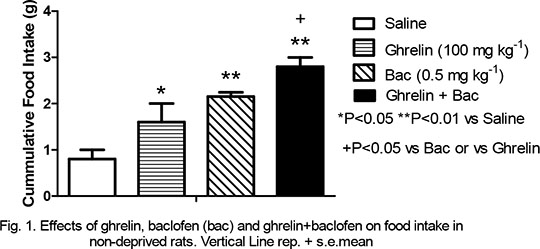Effects of baclofen and ghrelin on food intake in non-deprived rats There are a number of similarities between the effects of the GABAB receptor agonist baclofen (bac) and the gut peptide ghrelin on food intake. For example, both drugs increase food intake in non-deprived rats after central or systemic administration but not in food-deprived rats (see Ebenezer et al., 2011 Wren et al., 2000). Furthermore, preliminary results from our laboratory indicate that systemic administration of bac elevates blood plasma levels of ghrelin in rats (Bains, Shute and Ebenezer, unpublished results) The present study was conducted to examine if submaximal doses of i.p. bac and ghrelin. interact synergistically to potentiate food intake. Male Wistar rats (n = 8; body weight: 260 - 350 g) were given a single bolus i.p. injection of either saline (sal), bac (0.5 mg kg-1), ghrelin (100 μg kg-1), or bac (0.5 mg kg-1) + ghrelin (100 μg kg-1). The rats were placed in separate experimental cages immediately after the injection with free access to food and water for 60 min and food intake measured, as described previously (Ebenezer, 1990). A repeated measures design was used with each rat receiving all treatments; 2 – 3 days separated successive trials. The data was analysed by two-way ANOVA and the post-hoc Student Newman-Keuls test.

The results are shown in Fig. 1. Analysis of the data revealed that both ghrelin and bac on their own significantly increased food intake (P<0.05 and P<0.01 respectively). When ghrelin and bac were administered together food consumption was significantly increased compared with sal (P<0.01) or either treatment on their own (P<0.05 in each case). However, ANOVA revealed that there was no significant interaction between ghrelin and bac on food intake (F(1,7) = 0.1143, ns).This suggest that it is likely that the result may represent a summation of the effects of the two drugs of food intake acting independently on different neural pathways to mediate their actions on food consumption. Ebenezer, I.S. et al.(2011) Eur. J. Pharmacol., 635, 129 – 134. Wren, A.M. et al. (2000) Endocrinology, 141, 4325 – 4328. The study was supported by the European Union InterReg TransChannel Neuroscience Network. Network.
|


